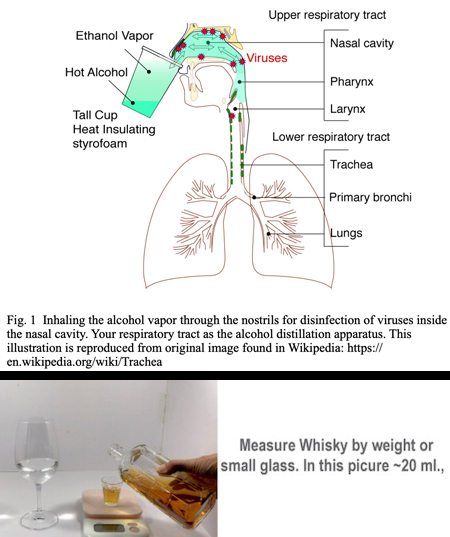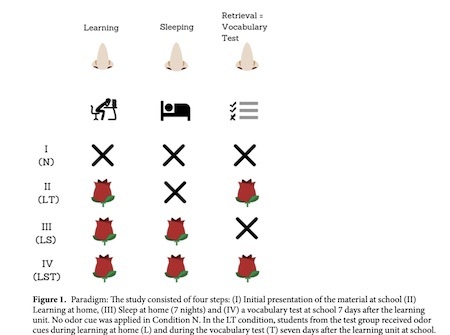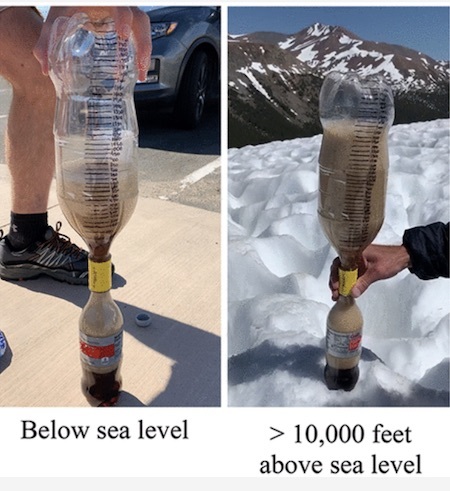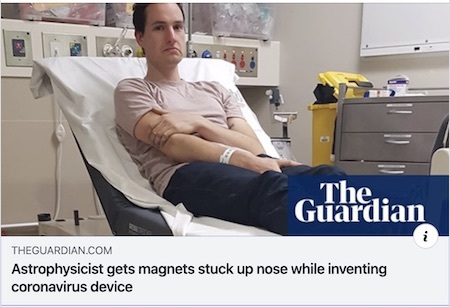Marc Abrahams's Blog, page 121
April 4, 2020
Fire Risk in Whisky-based Method of Disinfection of SARS-CoV-2
Protecting against the COVID-19 virus might—might—be able to involve both pleasure and risk, in the method outlined in a new study:
“Possibility of Disinfection of SARS-CoV-2 (COVID-19) in Human Respiratory Tract by Controlled Ethanol Vapor Inhalation,” Tsumoru Shintake, arXiv 2003.12444. (Thanks to Vaughn Tan for bringing this to our attention.) The author, at Okinawa Institute of Science and Technology Graduate University, Japan, explains:
How to Sterilize in our Respiratory Tract— As shown in Fig. 1, we inhale the ethanol vapor of alcohol solution at 50~60°C through the nostrils using a tall cup (heat insulating styrofoam, or a wine glass). We fill ~30 ml Whisky, diluting with 30 ml hot water (90°C)….
if we use the spray for ethanol disinfection experiments, the outcomes would fluctuate greatly, and always higher concentration would be required. Also, in practice, the ethanol spray should be avoided, because of possible fire accident. Therefore, the author proposes inhalation of the ethanol vapor through the nose, which then condenses inside our respiratory tract, and thus disinfects the corona virus.

April 3, 2020
Using Odor to Try to Optimize Learning During Sleep
“To smell again, perchance to learn better” would be a poetical way to speak of this study about teaching sleeping children in Germany how to read and write better English:
“How Odor Cues Help to Optimize Learning During Sleep in a Real Life-Setting,” Franziska Neumann, Vitus Oberhauser, and Jürgen Kornmeier, Scientific Reports, vol. 10, no. 1227, 2020. (Thanks to Hans-Stefan Madlung for bringing this to our attention.)
The authors, at the University of Freiburg, Germany, explain:
All sticks were used in an unlit state, as they already distributed a highly intense fragrance as such. Depending on the experimental condition, the students were instructed to put the incense stick next to them on their desk while they were studying the English vocabulary at home, on their nightstand next to their bed while they were sleeping, and/or on their desk during the vocabulary test itself, which took place seven days after the initial presentation of the vocabulary in school. Having the incense stick on the nightstand during the whole night implied that the rose fragrance was supplied during the complete sleep period and in all sleep cycles….
We had to rely on the students’ reports on their use of the odor cues while studying at home and during their sleep in the seven nights between the initial encoding of the vocabulary material and the final test.

April 1, 2020
Restlessly Questioning the Effect of a Robotic Cat
Questions arise in and about the study “Questioning the Effect of a Robotic Cat in the Treatment of Terminal Restlessness,” by Jun Kako, Kohei Kajiwara, Masamitsu Kobayashi, Yasufumi Oosono, and Hiroko Noto, Journal of Palliative Medicine, vol. 23, no. 2, 2020, p. 158. The authors, at Hiroshima University and Kyushu University, Japan, explain:
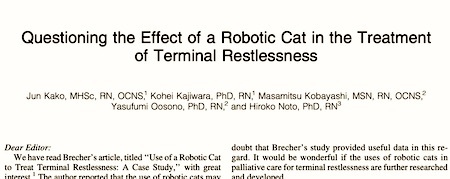
First, it is wonderful that the 90-year-old veteran was able to spend quality and calm time with his family and loved ones in his end of life and achieved a good death.
Second, we think that the use of a robotic cat was not the only factor in alleviating his terminal restlessness.…
Furthermore, infection control is a major concern regarding the use of robotic cats.

Podcast Episode #207: “The Psychoanalysts’s Nose”
The Psychoanalyst’s Nose, the Year of Lint, the Impact of Cold Wet Underwear, Boys Will Be Boys, the Pride of the Pride (of Lions), Hair (and Hare) Research, Social Dilemmas from the Not-So-Distant Past, Chewing on Knowledge, and Fold When Wet (If Naked Underwater).
March 31, 2020
Mentos + Cola at Various Altitudes
The mentos/cola experiment has reached new heights. Details are in the study:
“Probing the Mechanism of Bubble Nucleation in and the Effect of Atmospheric Pressure on the Candy–Cola Soda Geyser,” Thomas S. Kuntzleman and Ryan Johnson, Journal of Chemical Education, epub 2020. The authors, at Spring Arbor University and at Doherty High School, Colorado Springs, Colorado, report:
The so-called Diet Coke and Mentos experiment is initiated by dropping Mentos candies into a bottle of Diet Coke or other carbonated beverage. This causes the beverage to rapidly degas, causing foam to stream out of the bottle. Simple application of the gas laws leads to the straightforward prediction that ejection of greater foam volume is expected at lower atmospheric pressure. This hypothesis is bolstered when principles of bubble physics are taken into account. This hypothesis was tested and confirmed by monitoring the foam produced during the Diet Coke and Mentos experiment at various altitudes above sea level.
Author Tom Kuntzleman sent us this lovely note:
Ryan Johnson and I recently examined the effect of altitude (and therefore atmospheric pressure) on the Diet Coke and Mentos experiment. To do so, we carried out the experiment in many places around the US at altitudes that ranged from below sea level in Death Valley to over 14,000 feet at the top of Pikes Peak. We had an absolute blast.
For my father’s day present in 2019, my family gave me permission to carry out Coke and Mentos experiments at various locations (elevations) as we traveled through Arizona, California, Nevada, and Utah for summer vacation.

March 30, 2020
British tradition: Bad music as strategic weapon
Musicians in Britain have begun playing bad music from their balconies, to drive the populace indoors and so protect them against the COVID-19 pandemic:
(Thanks to Katharine Sanderson for bringing this to our attention.)
British musicians perfected this strategy, though for a different purpose, in the 1500s:
Vile scrapers—Music to (damage) your ears
… Cockayne studied the two centuries she believes were crucial for establishing Britain as a vibrant producer of boiler-factory-quality music. Her complacency-rattling report, “Cacophony, or Vile Scrapers on Vile Instruments: Bad Music in Early Modern English Towns“, appeared in 2002 in the journal Urban History.
Cockayne dates the swelling of British bad vibrations to the 1572 vagabond laws, which “limited the opportunities for independent musicians to ply their trade”. Barred from joining the officially sanctioned acting companies, many performers literally took to the streets. Soon, England’s cities were chock-a-block with singers, street criers and instrumentalists of various inability.
This had consequences. Cockayne casts them in somewhat reserved language: “The reactions of people living in towns and cities between the mid-16th and mid-18th centuries who were unwillingly subjected to music that was cacophonous, or which caused them consternation or irritation, will be considered.” …

Astroquadromagnetoduonostrility
Science advances two nostrils at a time. Or moves in some other direction. The Guardian reports, on March 30, 2020:
An Australian astrophysicist has been admitted to hospital after getting four magnets stuck up his nose in an attempt to invent a device that stops people touching their faces during the coronavirus outbreak.
Dr Daniel Reardon, a research fellow at a Melbourne university, was building a necklace that sounds an alarm on facial contact, when the mishap occurred on Thursday night.
The 27 year-old astrophysicist, who studies pulsars and gravitational waves, said he was trying to liven up the boredom of self-isolation with the four powerful neodymium magnets.

Fingers-Only Glove [new patent]
Fingerless gloves, in one form or another, have been around for a very long time. But the reverse, a glove that has only fingers has only recently been invented. US-based inventor Adam Walker has come up with a device that sidesteps the time-consuming and (sometimes) difficult process of putting on (and taking off) a pair of gloves.
“[…] the use of gloves conventionally requires the time-consuming engagement of each of the individual fingers of the hand, along with the palm of the hand, within the glove itself. Such can be frustrating for example in the case of tight plastic or polymeric gloves, and for tight fitting fabric gloves. Further, there are many occasions where the wearing of gloves to shield fingers from a surface, or enhance the grip of fingers with such a surface, requires more time to engage the gloves, than the temporary contact, by a plurality of fingers with the anticipated surface, is worth.”
Not only that – says the patent – unlike traditional gloves, they’re stackable.
“The glove device can be formed in stacks of adjacent glove device bodies where each has covering sections engaged within the axial cavities of another of the stack.”
Note: The drawing shows the two-fingered + thumb version – the patent also covers four-fingered and four-fingered + thumb versions.
See : United States Patent 10,588,364, March 17, 2020.
Research research by Martin Gardiner

March 29, 2020
Troy and the Grizzly Bear
Anyone seeking distraction can find it in this documentary video, “Project Grizzly.” See Troy Hurtubise in his self-mythic quest to personally build and test a suit of armor that he hopes will let him spend time with grizzly bears. Troy was awarded the Ig Nobel Prize for safety engineering, in 1998, for the work documented here.

March 28, 2020
Improbable video: Michael Jacksonization, bomb bay door, bird
Michael Jacksonization, bomb bay door, and bird all appear in Improbable Research Collection #102:
Our series of tiny bits-and-pieces videos peeks at improbable research — research that makes people laugh, then think. Here, below, is a skimpy guide to these little videos. We might make some more.

Marc Abrahams's Blog
- Marc Abrahams's profile
- 14 followers


